Choosing the best camera lenses for travel photography is a very tricky decision. When you are on a trip or travel and you want to take memorable photos, your prime concern is to have the right lens or lenses that can help you in different situations. You need a lens with the appropriate focal length for shooting landscape, buildings, cityscape, portrait, and indoor. You need also a fast lens for low light situations. Finally, you need a small and light gear to take with you during your trip. In this post, I will discuss the various factors affecting your choice; then I will recommend some lenses that are my favorite for travel photography.

What to look for when choosing a lens for travel photography
When planning your gear for travel photography, it is normal to focus on getting a smaller number of lenses that work well in a wide variety of situations. The reality of travel and trip photography requires that you will be probably all day out sightseeing; you do not want to carry too much weight inside your photography bag.
Of course, there are always going to be compromises, it is hard to find a lens that does everything well, and does not cost too much, and is lightweight! However, for travel photography, I think there are some good travel lens options out there.
First, let us go through the factors to be considered when choosing a lens for travel photography:
- Focal Length:
According to your destinations, you may want to shoot landscape photos. Sometimes you may want to shoot indoors (in museums and churches) with a low light situation or take an environmental portrait for your friends. The variety of distance to subject distances means choosing a lens that is capable of a certain focal length range.
- Weight:
It is obviously clear that you need your lens to be small in size and less in weight because there are other gears to carry like an external flash, tripod, filters, spare batteries, charger etc, and you do not want to hear your back! By carrying a heavy bag.
- Lens speed
When shooting photos during travel or trips, you will find yourself shooting at different times of the day with varying light stations and having a lens that lets more light in the sensor (especially at the low light condition) could make all the difference. The aperture defines the amount of light that passes onto the sensor and it is measured in f-stops (i.e. f/4 or f/16). It also directly affects the depth of field or, in other words, how blurry you want the background to be compared to the subject you have focused on.
The lens speed is signified by the size of the aperture. For example, the Canon EF 24-105mm F/3.5-5.6 IS STM lens has an aperture of f/3.4-5.6. This means at the 24mm focal length the aperture is f/3.5 and at the 105mm focal length, it has a maximum of f/5.6. The lower the number the lighter the lens allows to hit your image sensor and the faster shutter speed you will be able to shoot at. When shooting in low light a fast lens is a real advantage.
- IMAGE STABILIZATION (IS)
Image Stabilization is a system built into the camera to help reduce the blurring of the exposure that is usually associated with shooting in low light conditions and slower shutter speed. With lower shutter speeds, the potential risk of getting some camera shake is high.
Having a lens with image stabilization, along with a tripod, will drastically reduce the camera shake, and hens illuminate the appearance of blurriness in your photos allowing you to shoot in low light conditions. So, when choosing the best lens for travel photography always make sure that your lens has IS system.
- COST:
When choosing the right gear for travel photography the cost of the lens is a factor to take into consideration. While lenses can be costly, it is always best to invest more in your lens collection than the camera body.
Recommendation:
There are a few options for lens types. My suggestion would be to invest in three lens types: a wide-angle lens, a walk-around (do-it-all) lens, and a fast prime lens.
-
Wide-angle lens
Canon EF 16-35mm f/4L IS USM Lens
It is perhaps Canon’s best lens for landscape photography due to its ultra-wide capabilities on a full-frame camera and its ability to produce very sharp images with a little chromatic aberration or vignetting.
This ultra-wide Canon lens is incredibly sharp, and it is an excellent choice for landscape, indoor, and architecture lovers. It is our current go-to lens for these purposes in our travel photography bag. Whilst the f/4 aperture is not too wide, this lens features image stabilization technology that promises up to four stops of stabilization, which makes this a great choice for low-light work. It is also not too heavy. At f/8 – f/11 (a landscape photographer’s favorite place) this lens performs incredibly well and is hard to beat.
The following are sample photos


Product Highlights:
- Wide-angle zoom is designed for full-frame Canon EF-mount DSLRs, however, it can also be used with APS-C models where it provides a 25.6-56mm equivalent focal length range.
- Constant f/4 maximum aperture maintains consistent illumination throughout the zoom range.
- Two ultra-low dispersion glass elements noticeably reduce color fringing and chromatic aberrations for high clarity and color fidelity.
- Three aspherical elements minimize spherical aberrations and distortions for improved sharpness and accurate rendering.
- Super Spectra coating has been applied to individual elements to minimize ghosting and flare for greater contrast and color neutrality when working in strong lighting conditions.
- An Optical Image Stabilizer helps to minimize the appearance of camera shake by up to four shutter speed stops to better enable working in low-light conditions and with slower shutter speeds.
- A ring-type Ultrasonic Motor (USM), along with an internal focusing system, is employed to deliver fast, precise and quiet autofocus performance as well as full-time manual focus override.
- The rounded nine-blade diaphragm contributes to a pleasing out-of-focus quality that benefits the use of shallow depth of field and selective focus techniques.
- A protective fluorine coating has been applied to the front and rear elements to resist fingerprints and smudges and to make cleaning these elements significantly easier.
- As a member of the esteemed L-series, this lens is sealed against dust and moisture for working in inclement environmental conditions.
Specifications:
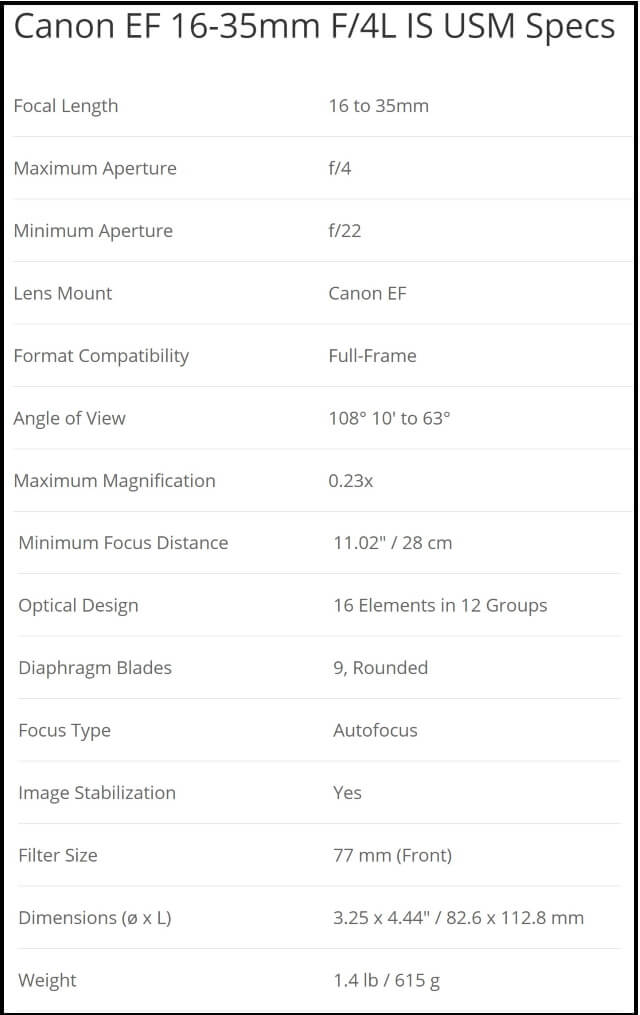
-
Walk around (do-it-all) lens
Canon EF 24-70mm f/4L IS USM Standard Zoom Lens
The EF 24-70mm f/4L IS USM is a Canon L-series lens covering wide-angle to short telephoto focal lengths and featuring a constant f/4 maximum aperture. An advanced optical layout is used to minimize a variety of aberrations and distortion in order to realize notable sharpness and clarity. A Super Spectra coating has also been applied to suppress lens flare and ghosting for greater contrast and color accuracy.
The lens is also characterized by its ring-type USM and internal focusing mechanism to enable quick, quiet, and precise autofocus performance along with full-time manual focus override. A dedicated macro position also enables focusing as closely as 7.9″ away in order to achieve a 0.7x magnification for photographing close-up subjects. A four-stop-effective Image Stabilizer is also used to minimize the appearance of camera shake for sharper handheld shooting.
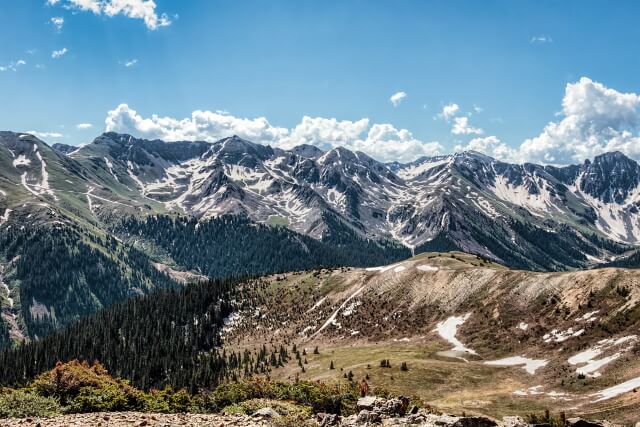
Product highlights:
- Standard zoom is designed for full-frame Canon EF-mount DSLRs, however, it can also be used with APS-C models where it provides a 38.4-112mm equivalent focal length range.
- Constant f/4 maximum aperture maintains consistent illumination throughout the zoom range.
- Two ultra-low dispersion glass elements noticeably reduce color fringing and chromatic aberrations for high clarity and color fidelity.
- Two aspherical elements minimize spherical aberrations and distortions for improved sharpness and accurate rendering.
- Super Spectra coating has been applied to individual elements to minimize ghosting and flare for greater contrast and color neutrality when working in strong lighting conditions.
- An Optical Image Stabilizer helps to minimize the appearance of camera shake by up to four shutter speed stops to better enable working in low-light conditions and with slower shutter speeds.
- A ring-type Ultrasonic Motor (USM), along with with with with an internal focusing design, optimized focusing algorithms, and a high-speed CPU, is employed to deliver fast, precise, and quiet autofocus performance as well as full-time manual focus override.
- A minimum focusing distance of 1.2′ is available throughout the zoom range and a dedicated macro position can be used to achieve a maximum magnification of 0.7x in conjunction with a minimum focusing distance of 7.9″.
- The rounded nine-blade diaphragm contributes to a pleasing out of focus quality that benefits the use of shallow depth of field and selective focus techniques.
- A protective fluorine coating has been applied to the front and rear elements to resist fingerprints and smudges and to make cleaning these elements significantly easier.
- As a member of the esteemed L-series, this lens is sealed against dust and moisture for working in inclement environmental conditions.
Specifications:
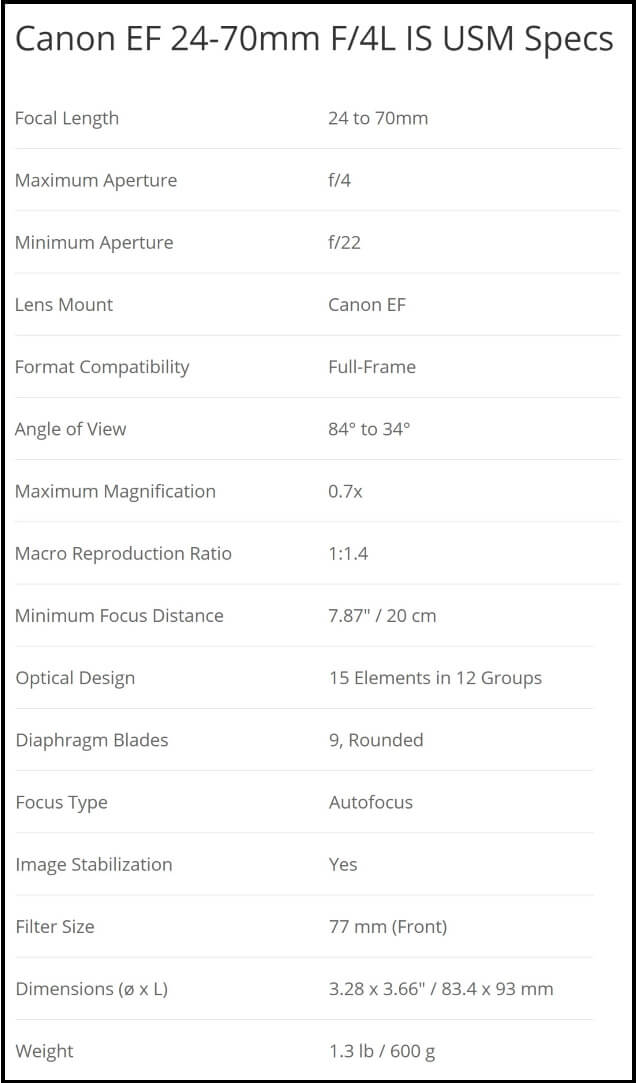
Canon EF 24-105mm F4L IS II USM
The image quality of this lens is renowned as one of the best zoom lenses going around. This is an ‘L’ series lens, which is a ‘luxury’ or Pro level. Its focal length is wide and will cover a variety of situations and needs. While f/4 isn’t super-fast it will do you fine in many lighting situations – especially anything shot in daylight. this lens has Image Stabilization (IS) which will allow you to handhold shots at up to 2 stops faster than normal (this means in low light you can slow your shutter speed a couple of stops without suffering camera shake).
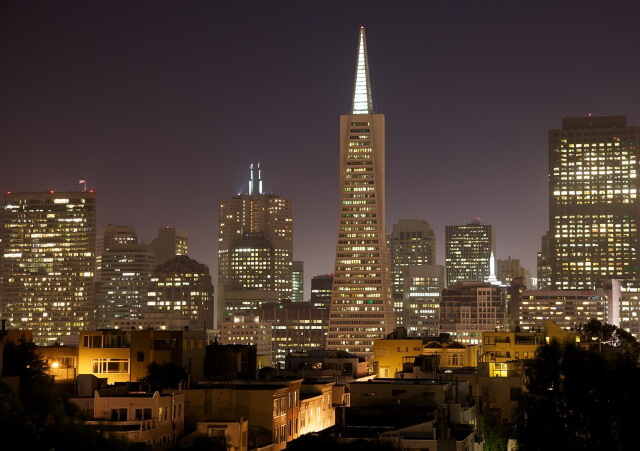
Product highlights:
- Standard wide-angle to a telephoto zoom lens is designed for use with full-frame Canon EF-mount DSLRs, however, it can also be used with APS-C models where it will provide a 38.4-168mm equivalent focal length range.
- Constant f/4 maximum aperture maintains consistent illumination throughout the zoom range.
- Four glass-molded aspherical elements, including one large-diameter double-sided glass-molded lens, help to minimize distortions and spherical aberrations throughout the zoom range in order to maintain edge-to-edge sharpness and illumination.
- An Air Sphere Coating has been applied to individual elements to reduce backlit flaring and ghosting for greater contrast and color fidelity in strong lighting conditions.
- An Optical Image Stabilizer helps to minimize the appearance of camera shake by up to four shutter speed stops to better enable working in low-light conditions and with slower shutter speeds.
- A ring-type Ultrasonic Motor (USM), along with with with with with an internal focusing design, optimized focusing algorithms, and a high-speed CPU, is employed to deliver fast, precise, and quiet autofocus performance as well as full-time manual focus override.
- The rounded ten-blade diaphragm contributes to a pleasing out of focus quality that benefits the use of shallow depth of field and selective focus techniques.
- As a member of the esteemed L-series, this lens has a weather-resistant design that protects against dust and moisture to enable its use in inclement conditions. Additionally, fluorine coatings have also been applied to the front and rear lens elements for further protection against fingerprints and smudging.
Specifications:
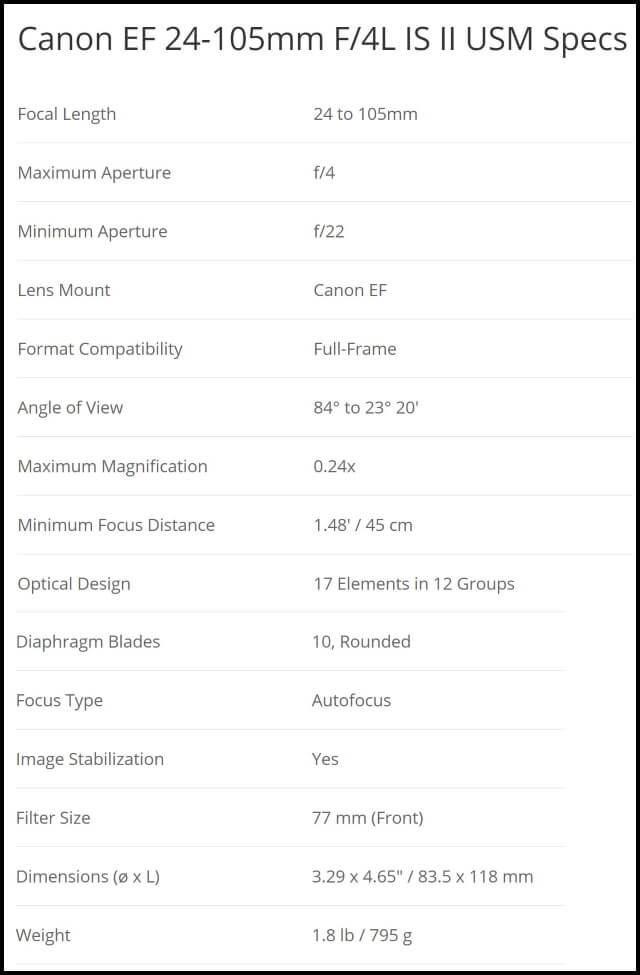
-
Prime lens
Canon EF 50mm f/1.8 STM
This lens is considered one of the most affordable lenses you will find in the Canon range when you take into account the quality of the images it produces. it is significantly faster than any of the other lenses mentioned above at f/1.8. This will allow you to shoot at quite low light levels.
It is great when shooting indoors, especially when a flash is not allowed or appropriate. It is very light and very affordable. As for the image quality, you may consider it as the one that has the best quality lenses going around on a ‘dollar to quality ratio’.
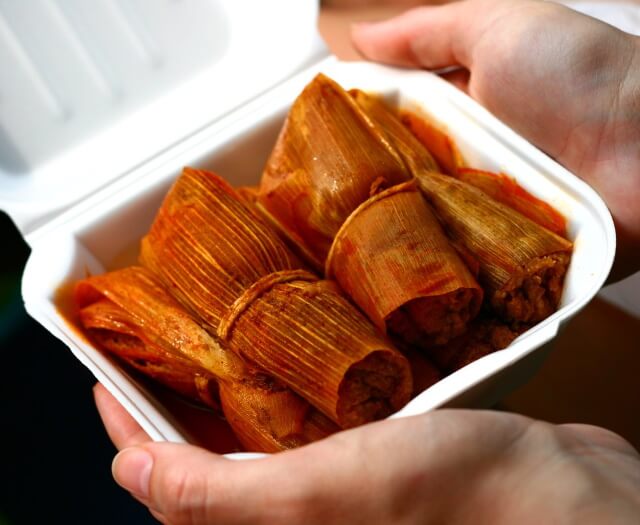
Product highlights:
- Normal-length prime is designed for full-frame Canon EF-mount DSLRs, however, it can also be used with APS-C models where it provides an 80mm equivalent focal length.
- Bright f/1.8 maximum aperture enables control over depth of field for selective focus applications and also benefits working in low-light situations.
- Super Spectra coating has been applied to individual elements to minimize ghosting and flare for greater contrast and color neutrality when working in strong lighting conditions.
- An STM stepping AF motor realizes smooth, near-silent autofocus that is complemented by advanced AF algorithms and a high-speed CPU for fast AF performance. Additionally, a full-time manual focus override is also available.
- The redeveloped physical design incorporates a metal lens mount for durability as well as a re-located focusing ring to maintain a compact form factor.
- The rounded seven-blade diaphragm contributes to a pleasing out-of-focus quality that benefits the use of shallow depth of field and selective focus techniques.
Specifications:

Canon EF 35mm f/2 IS USM
When you are choosing a lens for travel situations, one of the most common subjects for photos is the landscapes. Moreover, it is well known that when you photograph landscapes, a wide-angle lens is ideal. Although this lens is not quite wide it can pretty much capture the landscape as you see it with your own eyes. That means that the images you take with a 35mm lens look right and are comfortable to view.

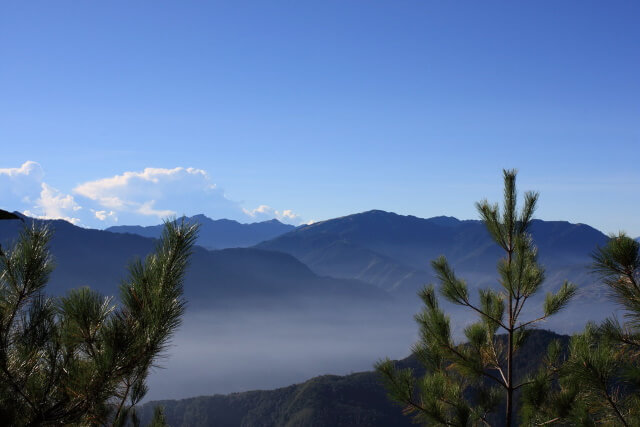
Product highlights:
- A wide-angle 35mm f/2 lens is designed for full-frame Canon EF-mount DSLRs, however, it can also be used with APS-C models where it provides a 56mm equivalent focal length.
- Bright f/2 maximum aperture benefits working in low-light conditions and also affords significant control over depth of field for working with selective focus techniques.
- One glass-molded aspherical element helps to suppress spherical aberrations and distortion for a high degree of sharpness and accurate rendering.
- Super Spectra coating has been applied to individual elements to minimize ghosting and flare for greater contrast and color neutrality when working in strong lighting conditions.
- An Optical Image Stabilizer helps to minimize the appearance of camera shake by up to four shutter speed stops to better enable working in low-light conditions and with slower shutter speeds.
- A ring-type Ultrasonic Motor (USM), along with a rear focusing system, is employed to deliver fast and precise autofocus performance as well as full-time manual focus override. Additionally, a micro-stepping drive also provides quiet focusing performance and a low-speed focus drive is used to benefit video recording applications.
- The rounded eight-blade diaphragm contributes to a pleasing out of focus quality that benefits the use of shallow depth of field and selective focus techniques.
Specifications:
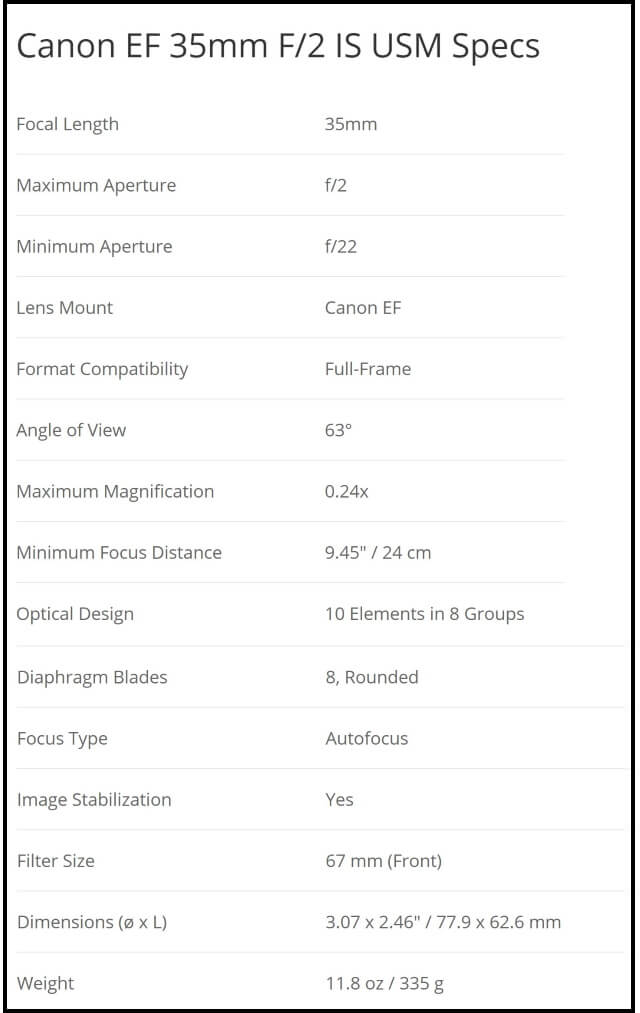
Thanks for reading, I hope you enjoyed the article if you have any questions just post them below & I will be happy to answer you.
If you enjoy the site, don’t forget to subscribe, we will only inform you when a new article is posted.





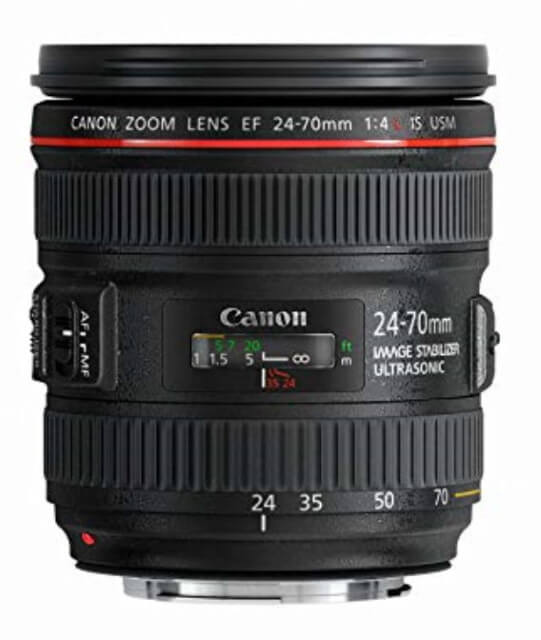
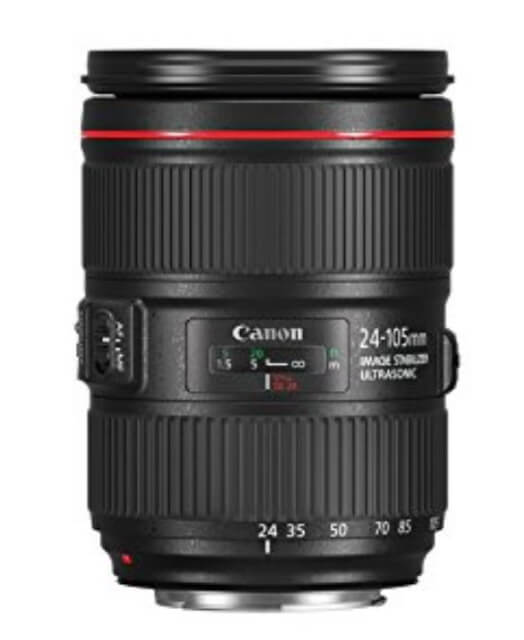
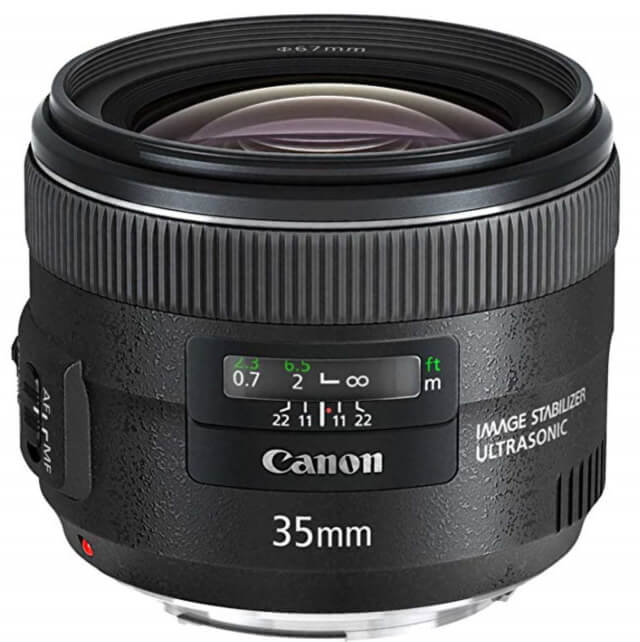

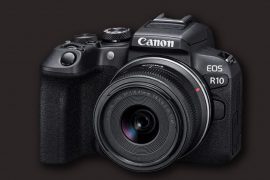
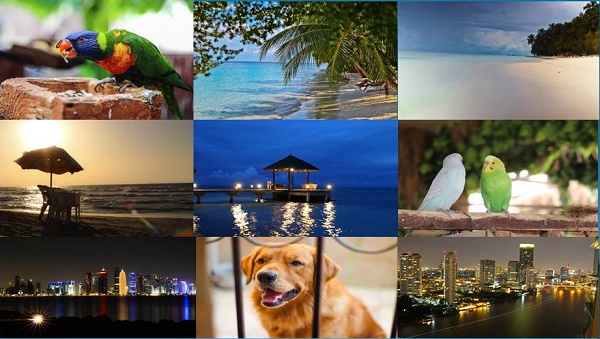
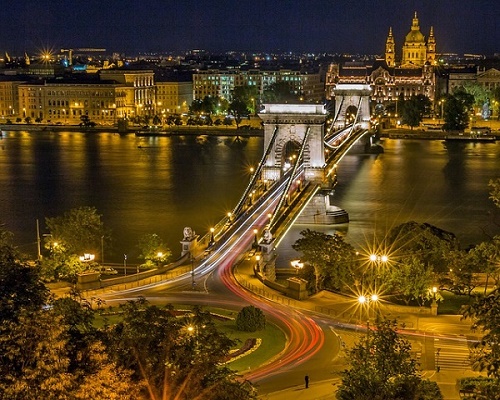

In every camera, there is one important thing that can make the picture quality and also make it look even better and this one thing is the lens and this is the reason why I feel like this is a very good post that you have written with some very good lens that one can really buy. I think I will go for one of these. Thanks for shring.
Thanks for educating me on how to choose the best camera lens for taking travel photos. I enjoy taking photos when I travel but I am by no means an expert so this information is extremely helpful to me.
I did not realize there were so many factors involved. I am glad to know that it is better to invest more for lens that the camera itself. Also thanks for the recommendations.
I can really see the difference by observing your sample photos compared to the ones I take. You have provided a lot of in depth information on this which I appreciate. Thank you Amin for this education.
I really appreciate your nice comment, many thanks!
That is such a great article on the Best Camera Lens for Photography. I love taking photos myself with my small camera and I have never thought of doing it professionally. I love the walk around (do-it-all) lens because that will be multipurpose for me and will do a lot of photos anywhere. Keep up the good work. Can you recommend your favorite lens, please?
Thanks, I agree with you about your lens, personally, my favorite one is Canon EF 16-35mm f/4L IS USM Lens